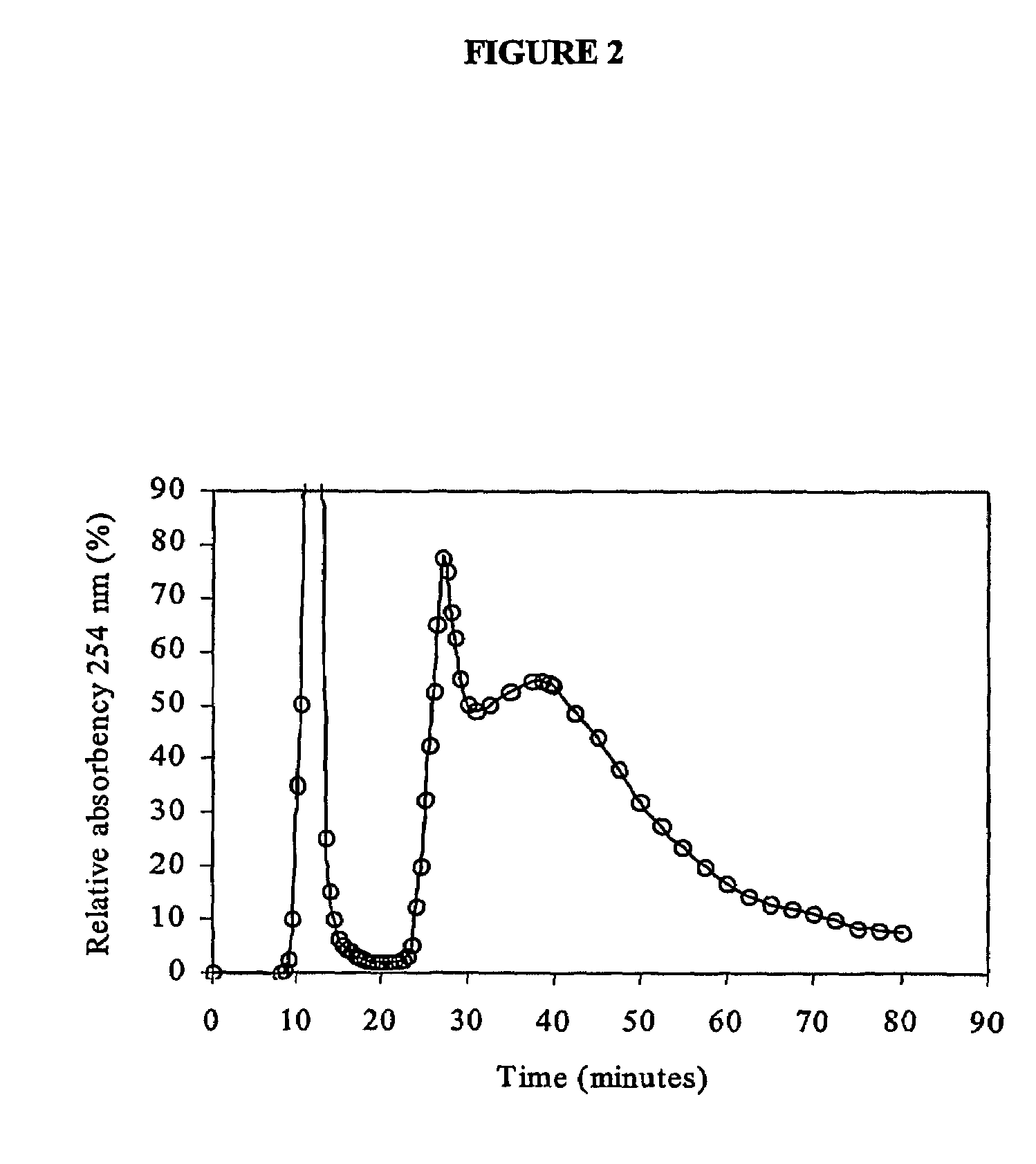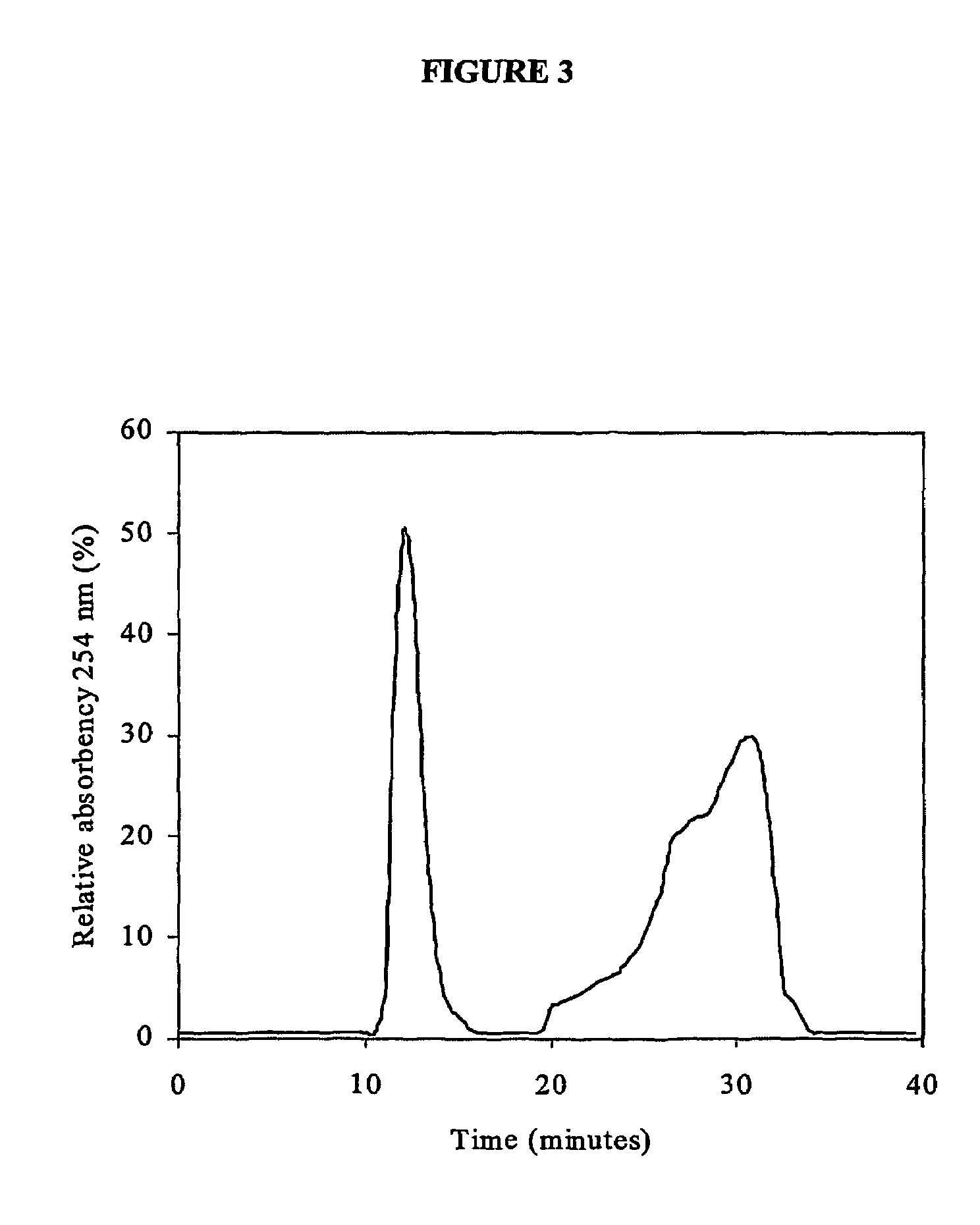Purification of plasmid DNA by hydrophobic interaction chromatography
a technology of hydrophobic interaction and plasmid dna, which is applied in the field of biochemical engineering/biotechnology, can solve the problems of insufficient laboratory-scale protocols, insufficient information relative to the purification methods for their large-scale production, and difficult process
- Summary
- Abstract
- Description
- Claims
- Application Information
AI Technical Summary
Problems solved by technology
Method used
Image
Examples
example 1
Preparation of Pre-Purified Lysates Containing a Plasmid DNA with 8500 Base Pairs
[0027]Cells of Escherichia coli (DH5α strain) were transformed with a plasmid with 8500 base pairs, and grown overnight at 37° C. in shake flasks containing LB (Luria Broth) culture medium, at an orbital stirring of 250 rpm. The cells were harvested at the end of the growth phase and separated by centrifugation at 18 000 g (15 minutes at 4° C.). The supernatant liquid was discarded. The cells were then lysed chemically in alkaline medium as described next. The cells corresponding to a culture medium of 500 ml were re-suspended in 25 ml of a solution with 61 mM glucose, 10 mM Tris buffer, pH 8.0 and 10 mM EDTA. The lysis was performed by addition of 25 ml of a pre-chilled (4–10° C.) solution with 200 mM of NaOH and 1% (w / v) of sodium dodecyl sulphate. The resulting solution was mixed gently and incubated on ice for 10 minutes. Next, the obtained lysate was neutralised by addition of 20 ml of a pre-chille...
example 2
Preparation of Pre-Purified Lysates Containing a Plasmid DNA with 6050 Base Pairs
[0030]Cells of Escherichia coli (DH5α strain) were transformed with a plasmid with 6050 base pairs, and grown overnight at 37° C. in shake flasks containing TB (Terrific Broth) culture medium, at an orbital stirring of 250 rpm. The cells were harvested at the end of the growth phase and separated by centrifugation at 18 000 g (15 minutes at 4° C.). The supernatant liquid was discarded. The cells were then lysed chemically in alkaline medium as described next. The cells corresponding to a culture medium of 500 ml were re-suspended in 25 ml of a solution with 61 mM glucose, 10 mM Tris buffer, pH 8.0 and 10 mM EDTA. The lysis was performed by addition of 25 ml of a pre-chilled (4–10° C.) solution with 200 mM of NaOH and 1% (w / v) of sodium dodecyl sulphate. The resulting solution was mixed gently and incubated on ice for 10 minutes. Next, the obtained lysate was neutralised by addition of 20 ml of a pre-chi...
example 3
Preparation of Pre-Purified Lysates Containing a Plasmid DNA with 7067 Base Pairs
[0032]Cells of Escherichia coli (Top10F′ strain) were transformed with a plasmid with 7067 base pairs, and grown overnight at 37° C. in a fermenter containing 4 liters of TB (Terrific Broth) culture medium. The cells were harvested at the end of the growth phase and separated by centrifugation at 14 300 g (15 minutes at 4° C.). The supernatant liquid was discarded. The cells were lysed chemically in alkaline medium as described next. The cells corresponding to a culture medium of 4000 ml were re-suspended in 75 ml of a solution with 50 mM glucose, 25 mM Tris buffer, pH 8.0 and 10 mM EDTA. The lysis was performed by addition of 75 ml of a pre-chilled (4–10° C.) solution with 200 mM of NaOH and 1% (w / v) of sodium dodecyl sulphate. The resulting solution was mixed gently and incubated on ice for 10 minutes. Next, the obtained lysate was neutralised by addition of 56 ml of a pre-chilled (4–10° C.) solution ...
PUM
| Property | Measurement | Unit |
|---|---|---|
| flow rate | aaaaa | aaaaa |
| pH | aaaaa | aaaaa |
| pore diameter | aaaaa | aaaaa |
Abstract
Description
Claims
Application Information
 Login to View More
Login to View More - R&D
- Intellectual Property
- Life Sciences
- Materials
- Tech Scout
- Unparalleled Data Quality
- Higher Quality Content
- 60% Fewer Hallucinations
Browse by: Latest US Patents, China's latest patents, Technical Efficacy Thesaurus, Application Domain, Technology Topic, Popular Technical Reports.
© 2025 PatSnap. All rights reserved.Legal|Privacy policy|Modern Slavery Act Transparency Statement|Sitemap|About US| Contact US: help@patsnap.com



